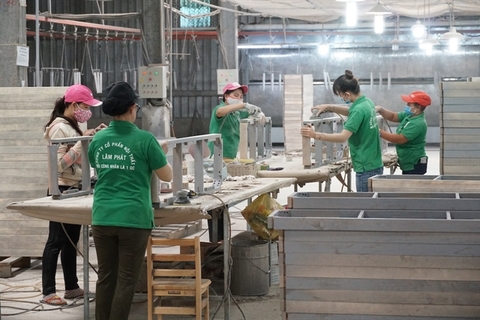
Rising input costs are eroding the profits of wood products manufacturers, putting them at risk.
Rising input costs are eroding the profits of wood products manufacturers, putting them at risk.
Additionally, Russia-Ukraine tension is likely to cause a shrinkage of Russian timber supply, compounding the situation, a conference on Wednesday heard.
 |
| Workers making furniture at a workshop. High input costs are holding back many wood product manufacturers. — Photo vneconomy.vn |
With timber supply becoming tighter, Vietnamese firms will have to compete more fiercely for timbers in international market, notably timbers from the EU and the US.
To Xuan Phuc, a policy expert at the non-profit organisation Forest Trends, said that Viet Nam had to import 5-6 million cubic metres of timber as input material every year.
The recent soaring demand for timber in timber-exporting countries has caused a shortage, pushing up prices. Higher material prices, coupled with mounting transportation costs, have added to import bills, driving many manufacturers into unprofitability.
The expert was concerned that timber prices would continue to climb in the short term, making Vietnamese wood products less competitive in the international market.
“Rising transportation costs and higher timber prices will erode the competitiveness of Vietnamese wood products in the international market,” he said.
Phan Van Phuoc, director of Tan Phuoc Co. Ltd., forecasts that timber shortage will last for 2-3 months and reach its peak in March.
He said his firm had to raise its product prices to remain operational and would not import additional timber in the short term due to high costs.
He added that if foreign customers do not accept his firm’s new prices, there was nothing he could do.
Nguyen Xuan Thuy, director of Lien Khanh Co. Ltd., underlined that tight timber supply was a hardship facing his timber-processing firm.
The firm had to stockpile timber months ago to produce enough material amid rising prices.
Despite mounting input costs, it is trying to keep processed timber prices stable at the expense of its own profits, thereby easing the burden on manufacturers.
“We are under increasing pressure to raise processed timber prices, but we will not do so in the short term for the good of manufacturers,” said the director.
Tran Quoc Manh, general director of Sai Gon Trading Production Development JSC, is more concerned about fuel costs than timber prices.
He said petrol prices had hit up to VND27,000 (US$1.18) per litre, exceeding manufacturers’ coping capabilities.
Accordingly, manufacturers are reluctant to sign new contracts for fear that petrol prices will continue to go up.
“Many manufacturers of wood products have to stay idle amid high fuel costs and freight rates. They are unwilling to sign new contracts due to cost uncertainties,” explained the director.
Policy expert Phuc shares this view, saying that rising oil prices have pushed up freight rates, bringing transportation costs to a new high.
He said freight rates had increased up to sixfold since the pandemic began, and Russian military operations in Ukraine were making things worse.
He believes transport costs will continue to go up in the near future, plunging manufacturers deeper into difficulties.
As the wood products industry is feeling the pinch of rising input costs, Chairman of Dong Nai Province’s Association of Wood and Handicraft Le Xuan Quan has urged relevant authorities to link up with shipping lines to stabilise freight rates.
He also called for close cooperation between forest growers and timber-processing firms to develop sustainable sources of timber for the industry, creating less dependence on imported materials.
Thuy stressed high fuel costs as a setback for the industry’s development, calling on the Government to cut taxes and curb fuel prices to help manufacturers.
He also believes that Viet Nam should spare no efforts to have its own timber certified by international organisations, notably the Forest Stewardship Council, to add value to its exported products.
Phuc recommends the Government introduce favourable policies that allow forest growing firms to contribute untapped lands to private firms.
He believes such a partnership will enable the latter to expand forests, creating more reliable sources of timber for the industry.
He also recommends the Government tightens up on risky imported timber to make more room for domestic supply.
General Import and Export Van Xuan Corp. has suggested a data portal on timber to help manufacturers monitor prices and supply to better manage input costs and inventories.
Vietnamese timber and wood product exports hit US$1.55 billion in January, up 14.3 per cent against the same period last year.
The industry aims to raise the figure to $18-20 billion by 2025.
(Source:VNS)




